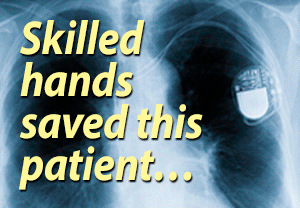 Post pm
Post pm
- by wmelanie
- 2010-09-15 08:09:49
- Checkups & Settings
- 1522 views
- 4 comments
Hi
I got a pm 2 weeks ago for second degree heart block (that happened only when I was exercising). Yesterday and today I went to the gym to ride the bike and my hr still dropped exactly like it did before the pm. Any ideas if this is just a setting problem? Would I know if I dislodged a lead? (I don't depend on the pm unless I am exercising)
Also, they said it would be burried and the nurse said it was too far under to be able to feel it. I can definitely feel it though with my fingers and it is just under the skin. Could it have moved? Or would the nurse just be mistaken on where it was placed? (Though the doc said he was going to bury it)
Its also sore going from there straight up to where they inserted the leads. The incisions themselves aren't really sore anymore but that line is quite tender. Is that normal?
Sorry for all the questions,
Thanks for the help!
Melanie
4 Comments
Pacemaker Questions
by SMITTY - 2010-09-15 11:09:27
Hi Melanie,
Welcome to the Pacemaker Club.
My guess is that the heart rate drop is a setting problem. If you don’t already know this, give the Dr a call and find out what your low set point is. If you are going below that set point it is time to check with the Dr.
The only way you are likely to know if you have dislodged a lead is your pacemaker would not be working at all. A quick PM check up will answer that question. But unless you have been using your arm by doing a lot of reaching or some other type of arm activity, it would be most unusual to dislodge a lead.
As for feeling your pacemaker, I’m on my second one and the first was buried under the muscle and I could feel it. The second one is supposed to be in the same pocket and I can feel it even more. In both cases the PM was much more visible for the first six months or so, than later.
I just noticed your statement "Its also sore going from there straight up to where they inserted the leads." Where did they put your PM? Mine is about an inch below my collar bone on the left side. In my case, with the PM being in that location, the leads travel about an inch or two before going into a vein and on into the heart. If yours is located differently, I’m afraid I don’t have a guess for you.
As for the soreness, if you are exercising, I would expect you to feel sore in the vicinity of the PM longer than it takes the incision to quit being sore. That PM is in, under or over a muscle. That muscle is likely to be sore longer than there is soreness of the incision because of the body movement during exercise.
You have had your pacemaker two weeks. If I could offer one suggestion it would be don’t be reaching conclusions about your pacemaker and your life yet. It can take from a few weeks to several months before we really know what our life is going to be like with a pacemaker. Fortunately, 99%+ of the time, we have a better life because of our pacemaker.
And don’t ever apologize for asking questions. If we didn’t get questions here, the site would probably just dry up and blow away.
Good luck to you,
Smitty
HR drop
by ElectricFrank - 2010-09-16 12:09:02
There is a setting in the pacemaker called Upper Pacing Limit or Upper Tracking Limit. This sets the maximum HR that the pacer will pace you at. It is common for the cardiologist to leave the pacer set at the factory upper limit of 120BPM at implant and figure on fine tuning it at the first check up. This works OK as long as the first checkup is soon.
The problem is that when you each the upper limit of 120, which doesn't take much at the gym the pacer starts skipping beats to enforce the limit. With a rapid increase in HR like happens on an exercise bike you can have your HR increase to 120 and then drop to 60 as it skips every other beat. This feels terrible and you would certainly feel it.
A second possibility just occurred to me. If you were depending on the HR monitor of the bike you may have been getting a false reading. With the typical monitors that read your HR by picking up the heart signals between the left and right hands on the handlebars, they have problems interpreting the unusual waves of the paced ECG. They can read HR's that are half actual, or double,or even jump between them. When you get the drop on the monitor take your pulse by feeling it and measuring the time with your watch.
hope this helps,
frank
MTR up of sensor
by sherida - 2010-09-18 06:09:31
If your heartrate is higher than the maximum tracking rate, Wenckebach behaviour will occur, (missing some beats) and will eventually block every second beat, which caused rate drop from MTR to half of it. In this case MTR should be programmed higher, in accordance with your age.
Other possibility is that not only the heartblock is the problem, but there might be sinus arrests. When the pacer is in DDD mode (not DDDR) your heartrate will drop to the Lower Rate, which might be 60 (unless some flywheel function is activated...).
Sure they will fix it at your next check up! But don't forget to mention!
You know you're wired when...
You know the difference between hardware and software.
Member Quotes
Sometimes a device must be tuned a few times before it is right. My cardiologist said it is like fine tuning a car.

.png)



new to this site
by willowrose - 2010-09-15 10:09:05
Hi, I also got a pm nearly 3 weeks ago, I had low heart rate, I was not told it would be buried, but I can feel it just under my skin, I didn't think I would be able to. I am trying to get use to it. It kind of bothers me at night when I am trying to sleep. My incision is not sore and the line is a little tender too. I too have a lot of questions,